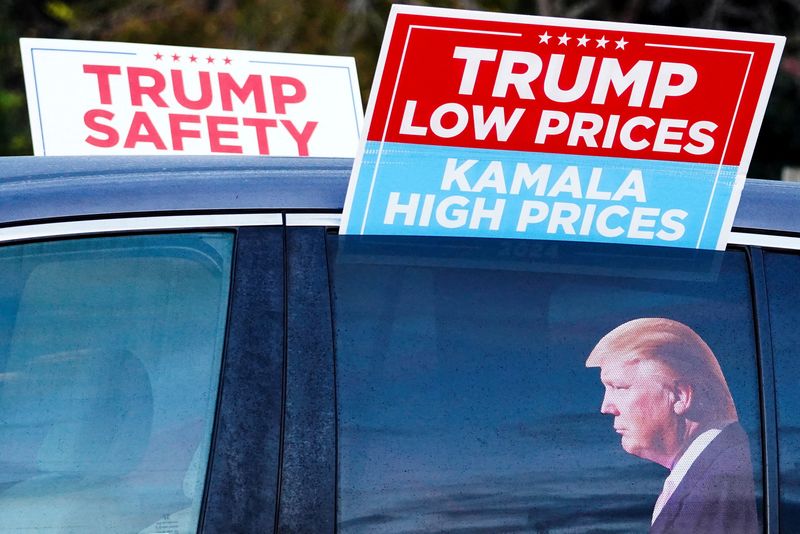Following his election victory, U.S. President-elect Donald Trump is set to implement sweeping policies aimed at reshaping the American economy, focusing on broad import tariffs, immigration restrictions, and substantial tax cuts. While some analysts anticipate these measures will provide a temporary boost to the economy, they are also cautioning that the long-term consequences may include heightened budget deficits, slower workforce growth, and increased inflation rates. Trump, a Republican, won the presidency by defeating Democratic Vice President Kamala Harris, and he will step into an economic landscape that has performed notably well under outgoing Democratic President Joe Biden, bucking expectations of a recession despite aggressive interest rate hikes by the Federal Reserve aimed at curbing inflation.
As Trump prepares to take office, he aims to leverage his authority to continue and expand upon the tax cuts established during his 2017 administration. These tax cuts are set to expire after 2025, but Trump has pledged to make them permanent. Additionally, he has proposed significant new tax breaks, including the elimination of taxes on payments from Social Security retirement, tips, and overtime income. However, these ambitious fiscal plans lack any proposed offsetting revenue measures other than increased tariffs. As a result, forecasts regarding the federal deficit’s trajectory vary widely, ranging from an increase of $3 trillion according to the conservative Tax Foundation to as much as $7 trillion per the Penn-Wharton Budget Model. If implemented, this fiscal agenda could lead to an initial acceleration in GDP growth during the years 2026 and 2027, followed by a pronounced slowdown as budgetary pressures tighten and the effects of restrictive immigration and trade policies take hold.
A significant part of Trump’s proposed economic agenda is a reinvigorated trade policy, which aims to impose a broad base of 10% tariffs on imported goods and even steeper tariffs on Chinese imports. Should these tariffs be enacted, average U.S. tariff rates could surge to 17.7%, the highest levels seen since the 1930s. Such a move would not only cause a considerable one-time increase in consumer goods prices but could also elicit retaliation from global trading partners, potentially igniting trade wars. Moreover, making good on his immigration policy promises, Trump could undertake mass deportations of undocumented migrants, which would likely hinder labor force growth, given that these individuals have contributed significantly to the workforce in recent years. This could lead to a slowing pace of job creation and invoke a competitive environment for hiring, thus driving wages upward.
The intersection of increased deficit spending, restrictive immigration controls, and a boost in consumer demand from tax cuts raises concerns about renewed inflation, which could thwart the Federal Reserve’s ongoing efforts to maintain a 2% annual inflation target. For instance, projections from Oxford Economics hint that inflation rates could be approximately two-tenths to three-tenths of a percentage point higher than baseline predictions. This uptick could result in the Federal Reserve adopting a more cautious approach regarding interest rate cuts, complicating monetary policy in the face of an inflationary environment.
As Trump embarks on his presidential term, his policies will likely bring about complex interactions within the economy. A presumed short-term economic boom could fuel a larger debate about the viability of sustaining such growth in the face of looming deficits and potential inflationary pressures. Economists foresee that by 2028, the economic growth that Trump might stimulate during his early years could slow significantly as the effects of increased red ink and restrictive policies set in. Conservative predictions indicate that while there may be initial gains, the long-term prospects involve navigating the consequences of heightened tariffs and a constrained labor market.
In conclusion, President-elect Trump’s ambitious plans stand poised to reshape the current economic landscape in the United States markedly. His approach includes continuation and expansion of tax cuts, aggressive import tariffs, and stringent immigration measures that promise both immediate economic gains and future challenges. As analysts weigh the possible outcomes of these policies, they emphasize the delicate balance between short-term boosts to GDP and the potential for long-term economic stress, particularly around inflated deficits and stunted workforce growth. The path forward hinges on how well these fiscal strategies can reconcile immediate economic demands with sustained growth and stability in the years to come.

